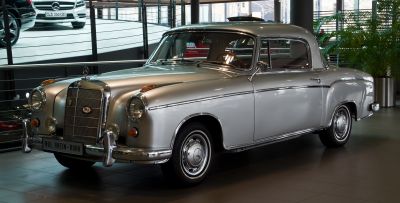 1956 Mercedes-Benz W180 II Coupe Dimensions, Size & Specs
1956 Mercedes-Benz W180 II Coupe Dimensions, Size & SpecsMeasurements of the 1956 Mercedes-Benz W180 II Coupe, engineered for optimal performance and comfort
| Dimensions | |
|---|---|
| Length: | 4700 mm185.0 in15.4 ft |
| Width: | 1790 mm70.5 in5.9 ft |
| Height: | 1530 mm60.2 in5.0 ft |
| Weight Specifications | |
| Curb Weight: | 1350-1365 kg2976-3009 lbs |
| Maximal permitted Weight: | 1790 kg3946 lbs |
The Mercedes-Benz Ponton W180 II Coupe, produced between 1956 and 1959, represents a quintessential example of mid-20th-century luxury automotive engineering. This classic coupe measures 4700 mm (185 inches) in length, offering a sleek yet substantial road presence. Its width spans 1790 mm (70.5 inches), providing a balanced stance on the road, while the height measures 1530 mm (60.2 inches), contributing to its elegant silhouette and comfortable cabin space. The curb weight of the W180 II Coupe ranges between 1350 kg to 1365 kg (approximately 2980 to 3009 lbs), reflecting its robust build quality typical of Mercedes-Benz vehicles of this era. The maximum permissible weight reaches 1790 kg (3946 lbs), which includes passengers and cargo, ensuring the vehicle maintains performance and safety standards. The Ponton series, renowned for its aerodynamic 'pontoon' styling, marked a significant evolution in Mercedes-Benz design, combining timeless aesthetics with advanced engineering. This particular coupe model stands out for not only its refined design but also its solid dimensions that balance comfort and sporty appeal. Whether considered for historical significance or collector interest, the Mercedes-Benz Ponton W180 II Coupe holds a distinctive position in automotive history with its impressive size, weight, and iconic styling.
Discover the standout features that make the 1956 Mercedes-Benz W180 II Coupe a leader in its class
Have a question? Please check our knowledgebase first.
The Mercedes-Benz Ponton W180 II Coupe, produced between 1956 and 1959, measures 4700 mm (approximately 185 inches) in length, 1790 mm (about 70.5 inches) in width, and 1530 mm (around 60.2 inches) in height. These dimensions reflect a compact yet elegant grand tourer design typical of the mid-1950s, providing a balanced silhouette with a spacious cabin relative to the car's coupe classification.
The Mercedes-Benz Ponton W180 II Coupe has a curb weight ranging from 1350 to 1365 kg (approximately 2976 to 3009 lbs). This moderate weight contributes to a stable and comfortable ride, enhancing road-holding and providing a smooth driving experience. The weight also affects acceleration and fuel efficiency, offering a balance between performance and drivability typical for luxury coupes of its era.
The maximum weight capacity of the W180 II Coupe is 1790 kg (around 3946 lbs). This includes the vehicle's curb weight plus passengers, cargo, and additional load. Adhering to this weight limit is crucial for safety, as exceeding it can compromise handling, braking, tire performance, and overall vehicle stability.
Typically, a standard garage measures about 6 meters (20 feet) in length, 3 meters (10 feet) in width, and 2.1 to 2.4 meters (7 to 8 feet) in height. With the W180 II Coupe's length of 4700 mm (185 inches), width of 1790 mm (70.5 inches), and height of 1530 mm (60.2 inches), it comfortably fits within these dimensions, allowing for easy parking and movement around the vehicle inside a standard garage.
Compared to its predecessor, the W120/W121 Ponton series, the W180 II Coupe is notably larger and more luxurious. The W180 II measures 4700 mm in length, which is typically longer than the earlier sedans that ranged closer to 4400 mm. The increased width and height also contribute to a more spacious interior and grander road presence, marking a progression in Mercedes-Benz’s focus on comfort and style during the late 1950s.
The W180 II Coupe's length of 4700 mm (185 inches) and width of 1790 mm (70.5 inches) were competitive with other luxury coupes of the 1950s such as the Jaguar XK140 and the BMW 507. While slightly wider than some contemporaries, its dimensions provided a balance between a sleek coupe profile and spacious comfort, positioning the Ponton coupe as a premium offering for affluent customers seeking both elegance and practicality.
While specific interior dimensions for the W180 II Coupe are less commonly documented, its exterior size allows for a reasonably spacious cabin, especially for a two-door coupe from the 1950s. The cabin was tailored for comfort with quality materials and ergonomic seating, providing ample headroom and legroom considering the overall height of 1530 mm (60.2 inches). The broader width of 1790 mm (70.5 inches) supports comfortable seating for four passengers in a tight but elegant setting.
The Mercedes-Benz W180 II Coupe's dimensions heavily influenced its classic and balanced design. The 4700 mm length allowed for elongated, elegant lines, while the width of 1790 mm gave it a sturdy and poised stance. The relatively low height of 1530 mm contributed to its sleek profile. The 'Ponton' styling included rounded edges and integrated bumpers, with smooth surfaces accentuating aerodynamic efficiency and timeless aesthetics.
The Mercedes-Benz W180 II Coupe typically featured a 2.2-liter inline six-cylinder engine producing approximately 106 horsepower. This powertrain provided reliable and smooth performance, paired with a 4-speed manual or an optional automatic gearbox. Though not a sports car, the coupe's engine offered a blend of adequate power for comfortable grand touring and the smoothness expected from Mercedes-Benz engineering of the era.
Given its moderate curb weight of 1350–1365 kg (2976–3009 lbs) and dimensions, the W180 II Coupe drove with a stable and composed demeanor. Its weight distribution and size allowed for comfortable cruising rather than sporty agility. Compared to lighter sports cars of the 1950s, the Ponton Coupe prioritized comfort, stability, and refinement, making it ideal for smooth highway driving rather than aggressive cornering.
Discover similar sized cars.

| Production: | 1958-1960 |
|---|---|
| Model Year: | 1958 |
| Length: | 4700 mm185.0 in |
| Width: | 1790 mm70.5 in |
| Height: | 1530 mm60.2 in |
